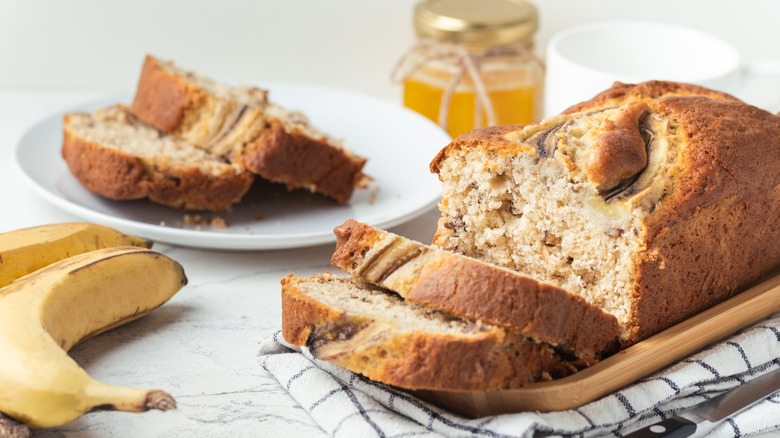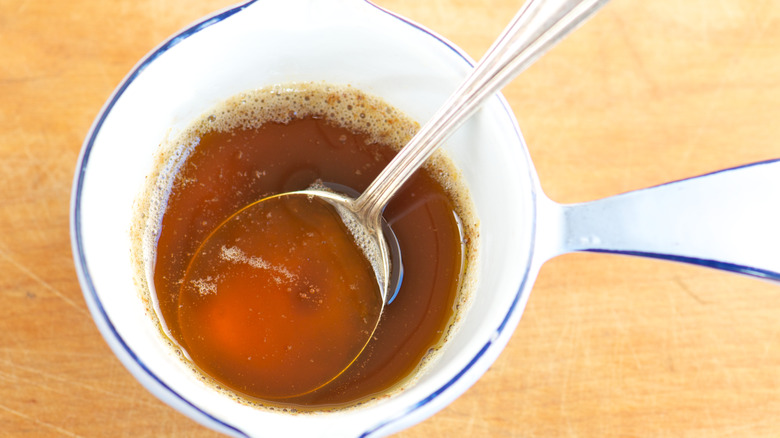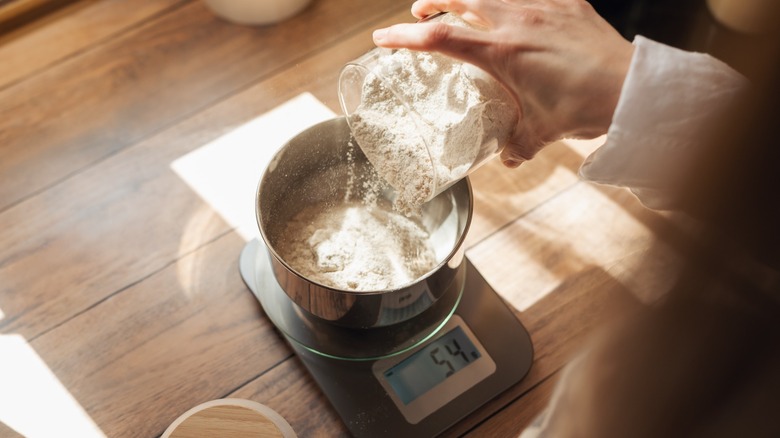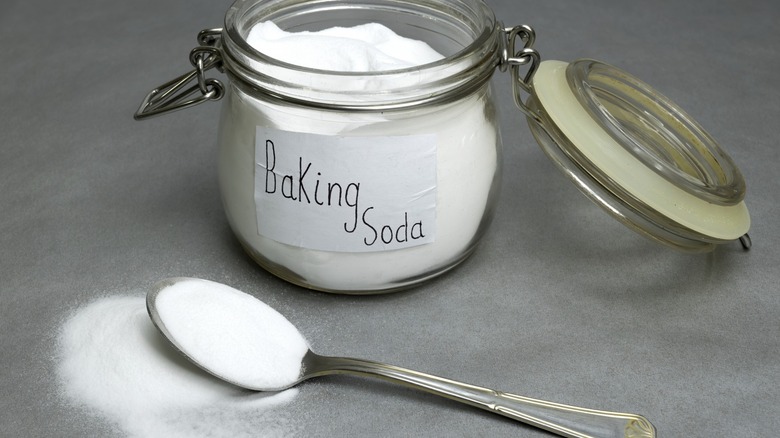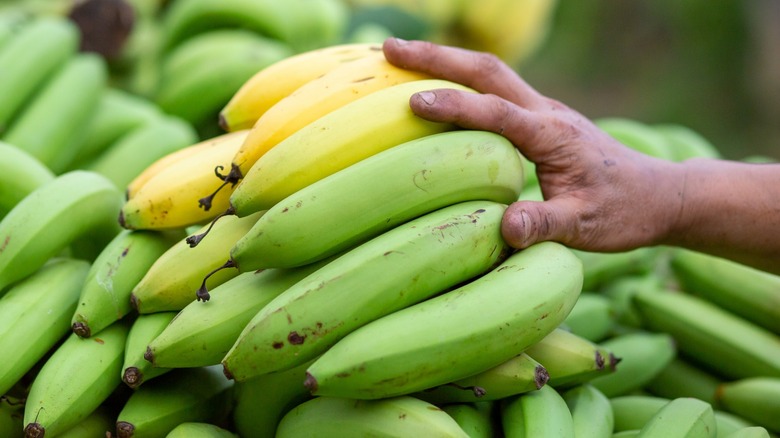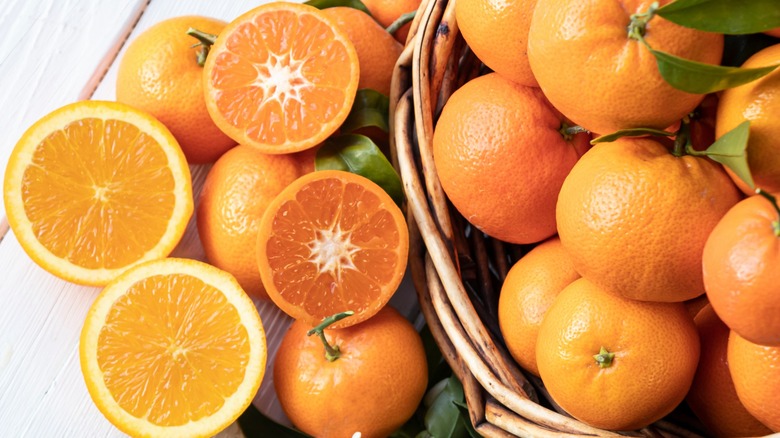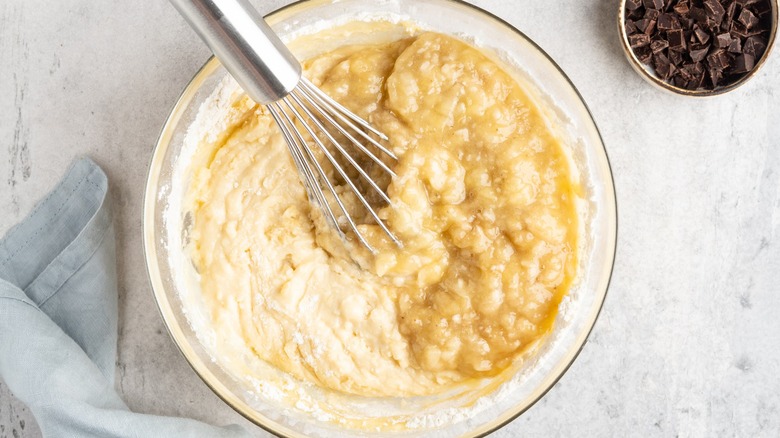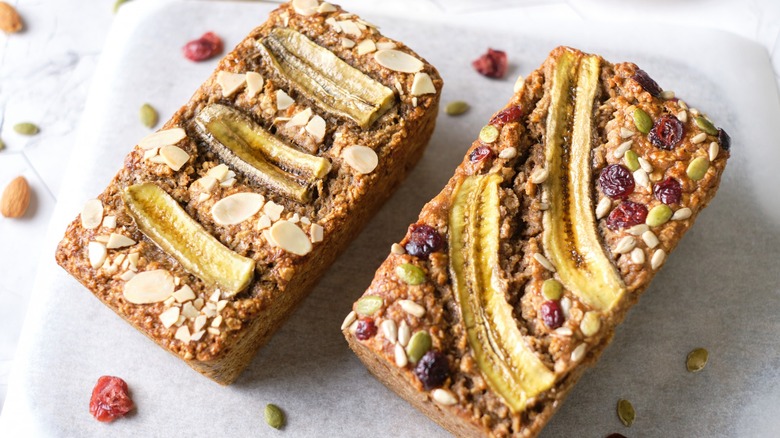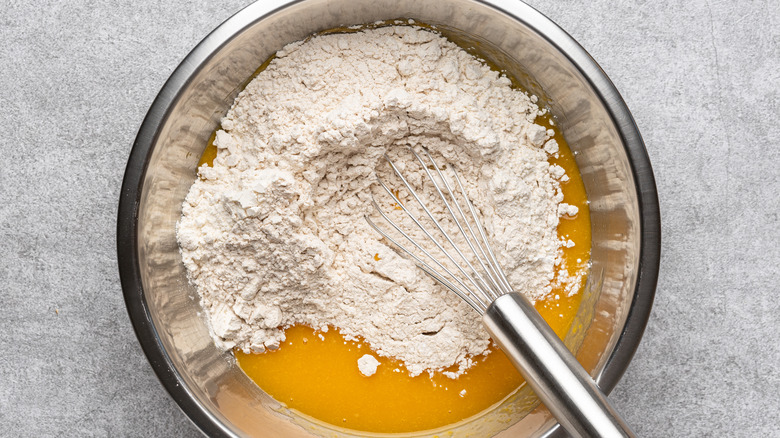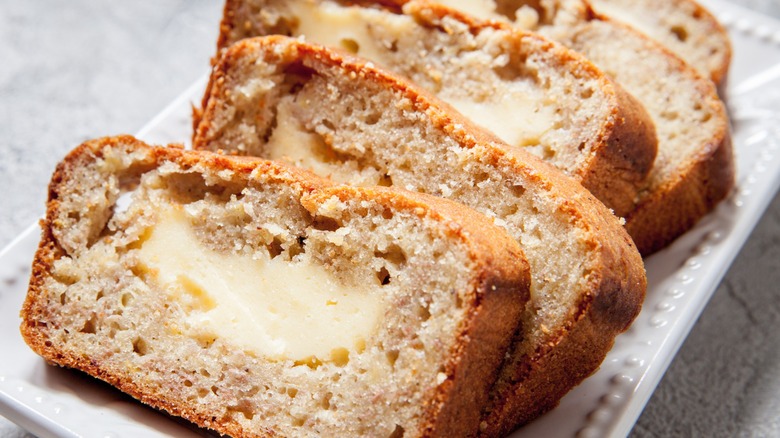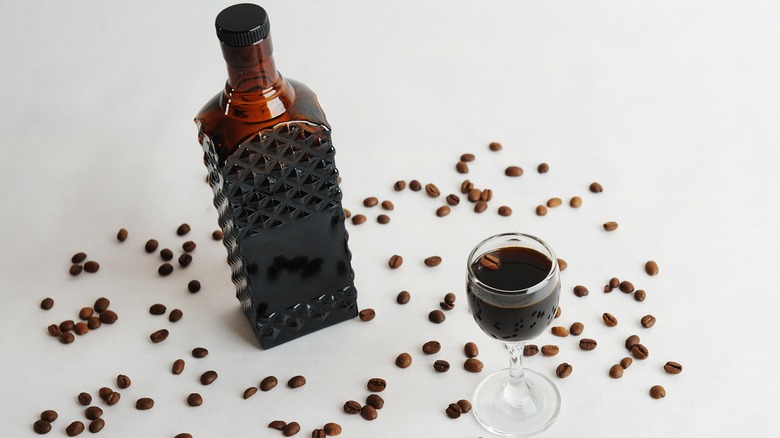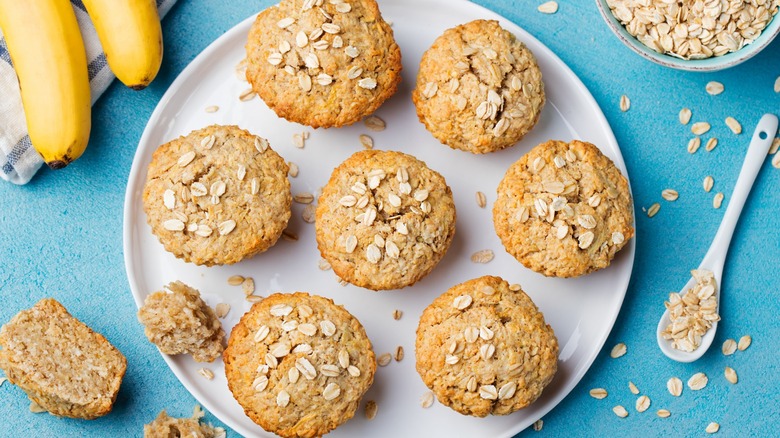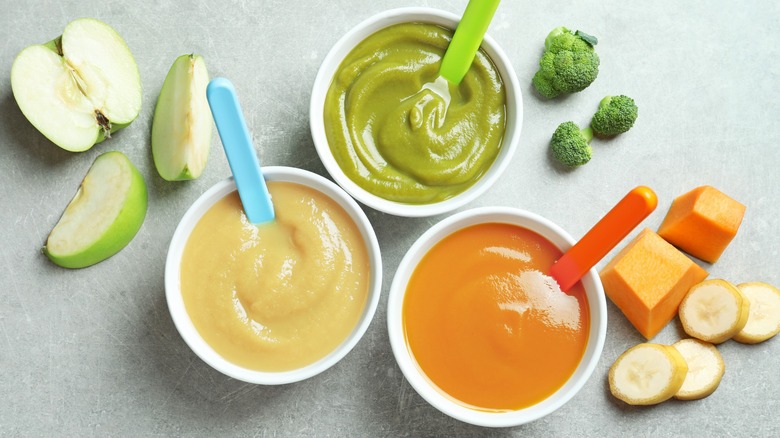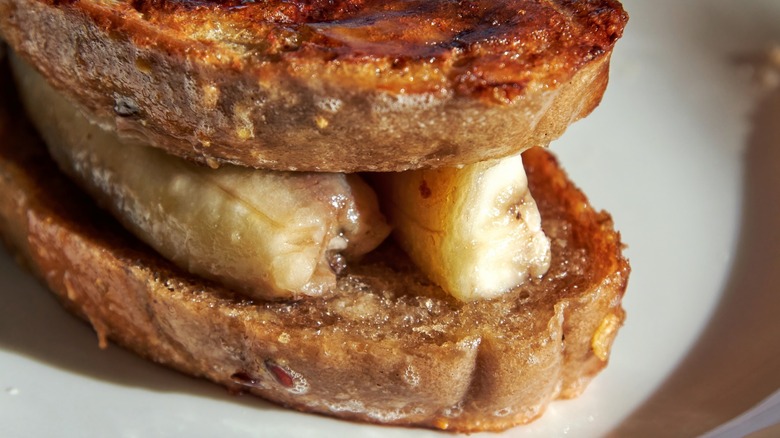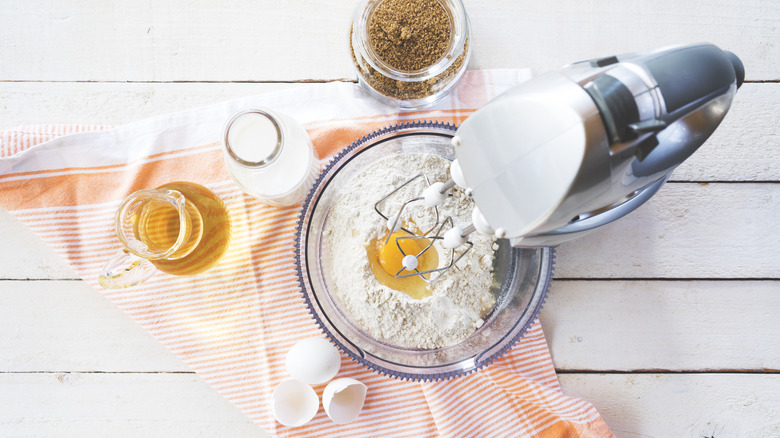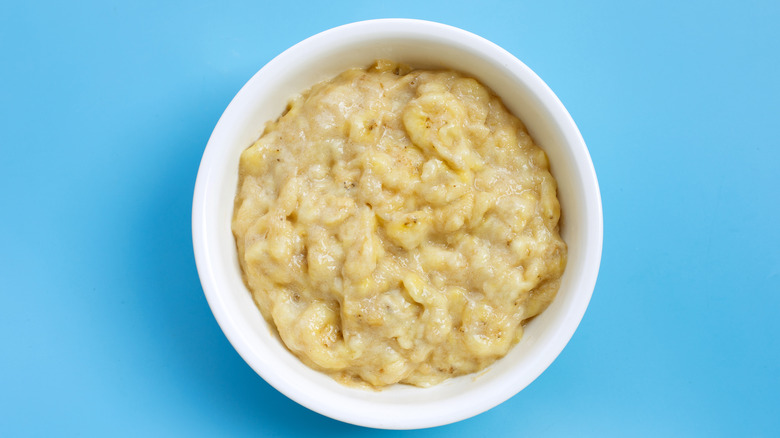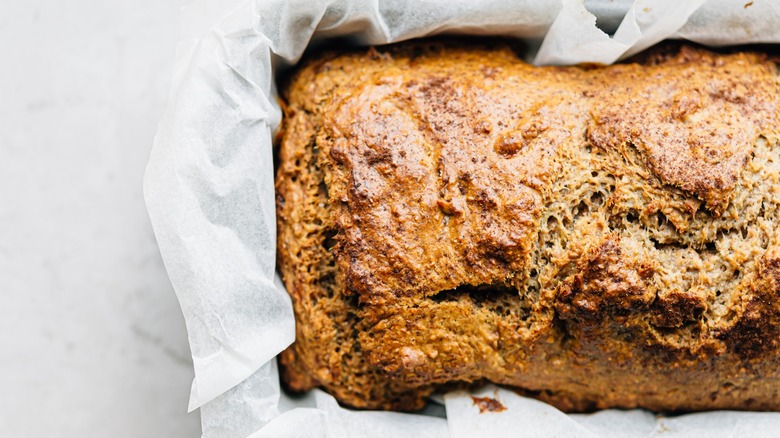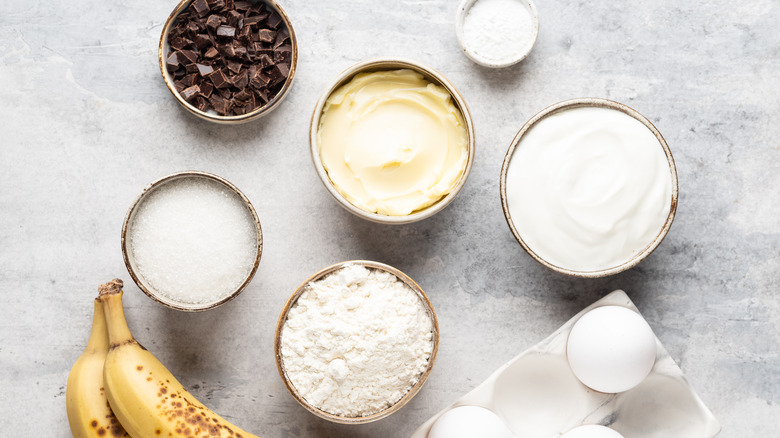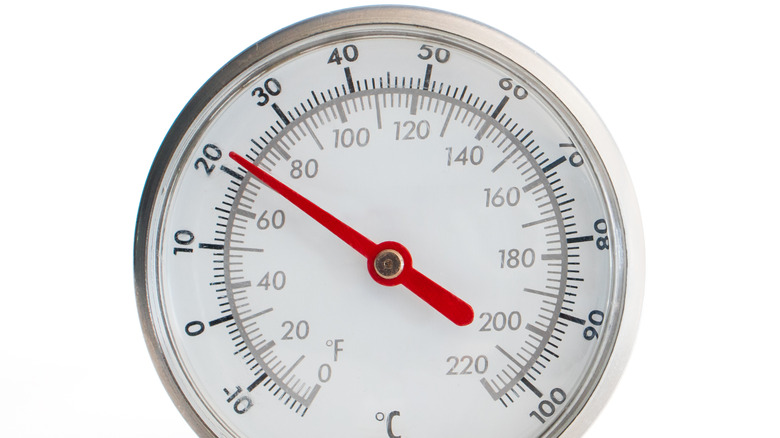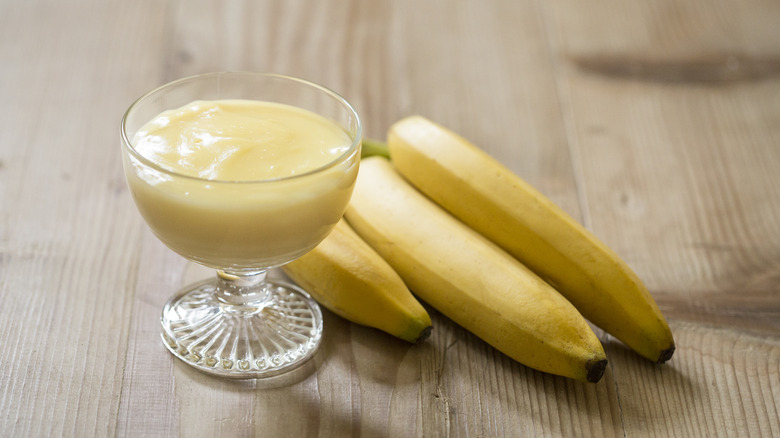19 Tips For Making The Best Banana Bread
The banana bread trend that kicked off during the height of the COVID-19 pandemic is still going strong — and it's easy to see why. It's hard not to love biting into a warm, subtly fruity, thick-cut slice of freshly baked banana bread, either made plain or schmeared with a sizeable portion of butter.
Besides being an easy way to cut down on bananas that would otherwise be thrown in the trash, banana bread is also an easily customizable recipe that you can make with whatever add-ins you have in your cabinets. Chocolate chips, nuts, and dried fruit are all ways to make your recipe unique and suited to your tastebuds.
Despite the ease of making banana bread, bakers can encounter some tricky bends along the way. Your bread might come out of the oven undercooked, dense, or, even worse, dry. Here are some of our best tips for making delicious banana bread.
1. Substitute regular butter with brown butter
Banana bread is a recipe known for its warmth, toastiness, and the feeling of biting into a cozy, inviting hug of flavor. If you want to make your banana bread taste a little more rustic without abandoning these notes, try swapping regular butter for browned butter in your recipe. Brown butter banana bread may take a few extra steps, most notably simmering the butter in a pan to toast the milk solids and evaporate the water, but the flavor you get from the loaf is surely worth it.
If you're short on time, or consider yourself to be a novice, make brown butter in the microwave. Add your butter to a microwave-safe container, noting that the browning process will decrease the volume of butter, and cook for 3½ to 6½ minutes. You'll know your butter is ready to go when it emits a toasty aroma and has small brown flecks.
2. Take the time to measure your ingredients precisely
Quick breads, like banana bread and pumpkin bread, are notoriously easy to make. But some simple steps can go wrong during the methodology of your baking experience that will upset your recipe. Measuring out your dry and wet ingredients correctly will ensure that your batter has the preferred consistency and is not too wet or too dry.
We recommend that you bake with a scale to avoid sabotaging your recipe. Since everyone's cup of flour or sugar looks a little bit different, baking by weight will ensure that you have the quantity of the ingredient that's on par with your recipe. Selecting a recipe that uses weights rather than cups or spoons is also a hallmark trait of one that is reliable and tested.
3. Check to see if your leavening agents are fresh
One of the reasons that many amateur bakers often drift toward quick bread recipes rather than traditional loaves, like baguettes or ciabatta, is because the quick bread is leavened with a chemical rather than yeast. Yeast tends to be very finicky, whereas adding baking soda or baking powder to your recipe will give you the rise without leaving you wondering about the exact temperatures or proofing.
However, this doesn't mean that using a chemical leavener is completely foolproof. You should always test it out by adding a bit of water for baking powder or an acid like vinegar for baking soda. If your mixture starts to fizz, you're good to go. When baking soda or baking powder expires (which is only about 6 months after opening), you won't get the same fizz and lift in your banana bread.
4. Only use bananas with the perfect level of ripeness
Banana bread recipes often call for "ripe bananas." But exactly how ripe is ripe, or too ripe? Ripe bananas develop more sugar over time, which makes them better for quick bread than pale green ones. In addition, mashing an underripe banana is difficult and will risk you leaving behind unpleasant hard chunks in your bread.
The perfect banana color for your recipe is yellow with black spots, or even plain yellow ones that have started developing a dark stem. However, your bananas may be too ripe for banana bread if they are black and spotted with white mold. Other visual cues include bananas that are secreting a mysterious liquid or ones that have an off-putting smell.
5. Use citrus for a boost of flavor
The secret to adding ingredients to your banana bread is to only incorporate those that enhance its flavor rather than transform it into something totally new. A simple way to elevate banana bread without changing its tropical profile is to add orange juice and orange zest. Adding the juice to your bread loaf will help keep it moist while also activating any of the alkaline leavening agents like baking soda.
The orange notes also play well with the warming spices of cinnamon and cloves in the recipe, as well as the popular additions of chocolate chips and walnuts. If you're going with the orange zest route, we recommend adding it to your recipe right before serving, as it will then impart the most profound flavor notes to your loaf.
6. Avoid over-mixing your batter
Quick breads are pretty resilient, but there's one mistake that is bound to ruin the texture and consistency of your recipe: overmixing your batter. Stirring the mixture too much once all of the ingredients have been added causes the gluten to develop in the batter, which gives it an elasticky, stringy texture. It can also cause you to beat all of the air out of the batter that you worked hard to create with your baking soda or baking powder which will lead to a disappointing deflation once it hits the heat.
To avoid this tricky bend, only stir the mixture enough to mix in the flour particles rather than mixing to the point where the batter starts to bounce back at you. You should also mix the dry and wet ingredients separately to avoid activating the leavening agents prematurely.
7. Include seeds for a crunchy element
The perfect banana bread has texture — and the best type of ingredient to give banana bread some crunch is seeds. You can sprinkle them on top of the loaf before you pop it into the oven or add them to the batter with your other mix-ins.
"Seeds" is a broad category that encompasses many different textures and flavors. Sunflower, pumpkin, and sesame seeds will all add a pleasant crunch, while flax and chia seeds can also act as an egg replacer in your recipe. In addition, seeds will increase the fiber content and add some healthy fats to your breakfast loaf. If you want to keep your seeds whole and crunchy, try toasting them before adding them to your recipe.
8. Use more than just plain flour
Most banana bread recipes call for the same standard all-purpose flour. But this doesn't have to be the only flour you use. For example, our recipe for buckwheat banana bread is made with a mixture of tapioca, almond, and buckwheat flour, which gives the bread a nutty undertone and a more flavorful bite than if you used plain all-purpose flour alone.
For more flavorful, caramelized banana bread, you can also alter the ratio of flour in your ingredients. Decreasing the amount of flour in your recipe will cause your bread to darken in color and develop a stickier interior. It will also taste sweeter since decreasing the flour concentrates the other sweet ingredients like the sugar and the banana.
9. Swirl in cream cheese
One ingredient that will change your banana bread forever can be found in the dairy section of your grocery store. Cream cheese can be swirled into the banana bread batter with the rest of your ingredients to create a cheesecake-like texture within your loaf. You can also stir it into your batter when you add it to the pan. This results in a balance of cream cheese and banana bread in every bite.
The cream cheese layer is typically made by whipping the dairy product with powdered sugar in a high-speed mixer. This blended addition doesn't overwhelm the sweetness of the bread, instead, it just helps curb the tanginess and acidity. Cream cheese banana bread pairs well with citrus, cocoa powder, or spices like cinnamon.
10. Add booze for more flavor
Booze isn't just for drinking. It's also a unique ingredient that can kick your banana bread up a notch. Kahlúa, a coffee liqueur, will boost the flavor of your bread and add mild coffee notes. You won't have to worry about getting drunk off a slice of bread since the temperature will burn off the residual alcohol — it's essentially the same concept as adding vanilla extract.
If you're working with a boxed banana bread mixture, you can substitute some of the water with the liqueur to infuse flavor. And if you're making a traditional banana bread, you can substitute some of the liquid in the recipe with a few ounces of Kahlúa. It's important not to add alcohol to the recipe without making proper substitutions. Too much liquid in the batter will alter the cooking time and make your loaf too wet.
11. Add toasted oats for a textural boost
We can learn a lot from acclaimed cooks. For example, celebrity chef Alton Brown's addition for perfect banana bread only takes a few extra minutes and it makes all the difference in your bread. Brown adds toasted old-fashioned oats to his recipe to prevent the loaf from getting mushy and soft.
To transform his oats, he places them on a half-sheet pan and bakes them until they are lightly toasted, which takes about 15 minutes. He then adds them to a food processor and pulses them into fine flour. Adding this ingredient may create a mealy texture, so it's important to bake your bread for the full recommended time to ensure that the oats will absorb all the liquid in the batter. The extra time will leave you with a delicious, soft bread full of oatmeal flavor.
12. If you're short on bananas, use baby food instead
It's difficult to get bananas in the perfect stage of ripeness. While you can add roasted bananas for a boost of flavor and sweetness or wrap your fruit in a plastic bag to speed up the ripening process, your timelines just might not match up. To get yourself out of this predicament, try using baby food.
Baby food is a secret ingredient that can save you time when you're making banana bread. All you have to do is mix up your jar of banana baby food and pour it into the batter with the rest of the wet ingredients. Most banana baby food is made with simple ingredients: banana, lemon juice concentrate, and vitamin C. There's no peeling or mashing involved, and you can easily substitute four medium mashed bananas for two 6-ounce jars of baby food.
13. Serve your banana bread slices toasted
Once your banana bread comes out of the oven, the smell will pull you in. You might even be tempted to take a slice and eat it straight from the pan. But that isn't the best way to take advantage of its texture. An easy way to improve lackluster banana bread (or make good banana bread even better) is to fry it on a griddle or cast iron pan.
Place your slices into the pan with a thin layer of melted butter to caramelize the outside of the bread and leave you with a crunchy, sweet bite. Be sure to cook it on medium-low to prevent burning the bread. This simple step can resurrect banana bread that's going stale and also salvage batches that were made with bananas that weren't quite ripe enough.
14. Don't skimp on the oil
The internet has been flooded with "healthy" banana bread recipes that are bound to make you feel "guilt-free" about eating them. You'll see recipes that tout the advantage of using a calorie-free sweetener like Splenda or substituting the flour with some ancient grain flour that is as much of a struggle to spell as it is to find in a grocery store. These healthy recipes may advise readers to avoid using oil in their recipes, too — but this is where we draw the line.
Oil is a crucial ingredient in the bread because it adds moisture without making the dough too wet. It's the key ingredient in our olive oil chocolate chip banana bread recipe because it makes the crumb soft and shortens the gluten strands in the flour. Don't skimp on it, don't leave it out, and don't add applesauce to make it "healthier."
15. Concentrate the banana flavor with a syrup
Have you ever made banana bread and had it come out ... not banana-y? Like you could bite in and not really tell what the bread was supposed to be? It's unfortunate, but it can be fixed with a straightforward trick. Try making banana syrup to get a more flavorful banana bread.
To do it, microwave your bananas in a covered container for up to 5 minutes before draining out the liquid and reducing it on the stove. The remainder of the banana can be added back into the batter with the reduced syrup, which will have a distinct caramel quality to it. To amp up the flavor, you can also add thinly sliced pieces of banana cooked in butter and brown sugar to the top of your bread before baking.
16. Use sugar for the perfect finish on your banana bread
The best part of a bakery-style muffin is the crystallized pieces of sugar on top. Every bite is a little bit crunchy, and the sweetness pairs so well with the decadent muffins. Each time we sprinkle this sweet ingredient over banana bread batter, we take a page out of the bakery playbook.
It's important to use sugar with a large crystal size that holds up well to baking. Demerara sugar is a good option because it will stay crunchy, while granulated sugar will just absorb back into the batter. You also don't need to brush the bread with oil, water, or egg to help the sugar stick, which makes this an easy hack for banana bread novices.
17. Use sour cream or Greek yogurt to keep your loaf moist
The secret ingredient to making sublime banana bread can be found in your fridge. Greek yogurt, sour cream — and even mayonnaise — can add a profound moistness to your crumb and prevent it from drying out in the oven. Add one of these creamy products to your recipe for extra moist banana bread, per its instructions.
It's important to note that these ingredients may impact other aspects of your bread besides just the moistness. The acidic element of these foods may activate your baking soda or leavening agents, which will result in a loftier cake. In addition, adding these ingredients may cut down on the need for oil or eggs, so it's best to read the recipe and use the exact amount of each ingredient it calls for.
18. Use a thermometer to determine when your banana bread is done baking
It's tricky to determine when to pull banana bread from the oven. The entire class of quick breads tends to get brown and solid on the outside but will remain underbaked on the inside until you, an unsuspecting baker, pull it out and slice it to reveal a molten interior. There are numerous ways to help ensure that your bread bakes evenly.
Preheating your oven and placing the loaf near the heating element can decrease its cooking time, but there's only one true way to determine when it's time to pull the loaf from the oven. Instead of relying on a skinny toothpick (which absorbs moisture and makes it difficult to tell if crumbs are clinging to it), stick a thermometer into the center of the loaf; the temperature will read between 200 and 205 degrees Fahrenheit when it is done.
19. Add pudding to keep the loaf moist
We're always looking for simple ingredients to amp up classic dishes — without spending an arm and a leg. Pudding is an inexpensive addition to perfectly moist banana bread that can be found in the baking section of your grocery store. Simply grab a 3.5-ounce box of instant vanilla pudding and mix it in with the recipe's dry ingredients.
It's important to use instant (not cook-and-serve) pudding in a neutral flavor like vanilla. Although you might be inclined to grab the banana variety, it tends to add an artificial flavor to the recipe. If you want stronger banana notes, add banana syrup or use extra-ripe bananas instead. You can also keep your bread moist by sandwiching it between two paper towels and placing it in an airtight container after it's adequately cooled.
